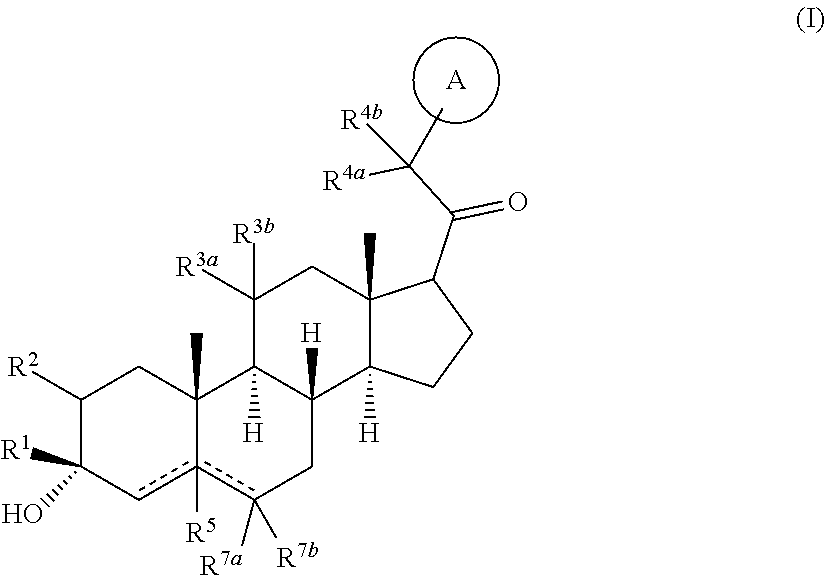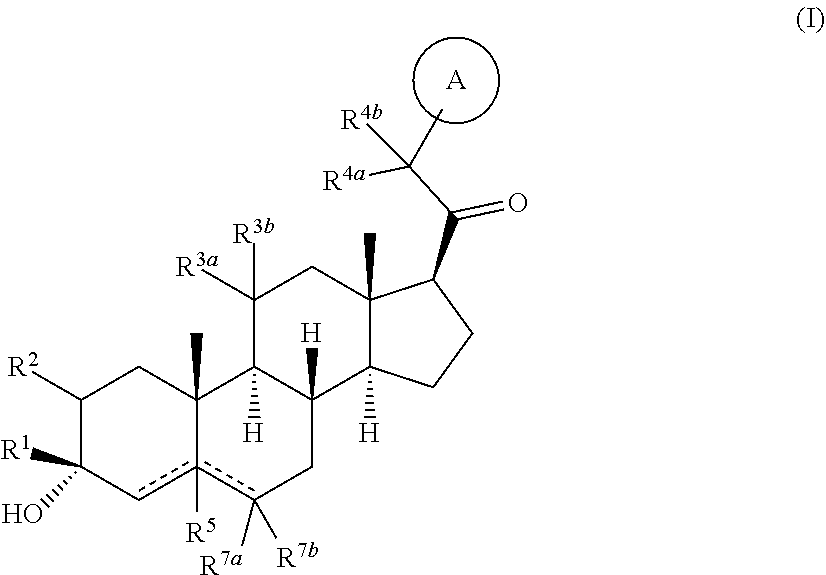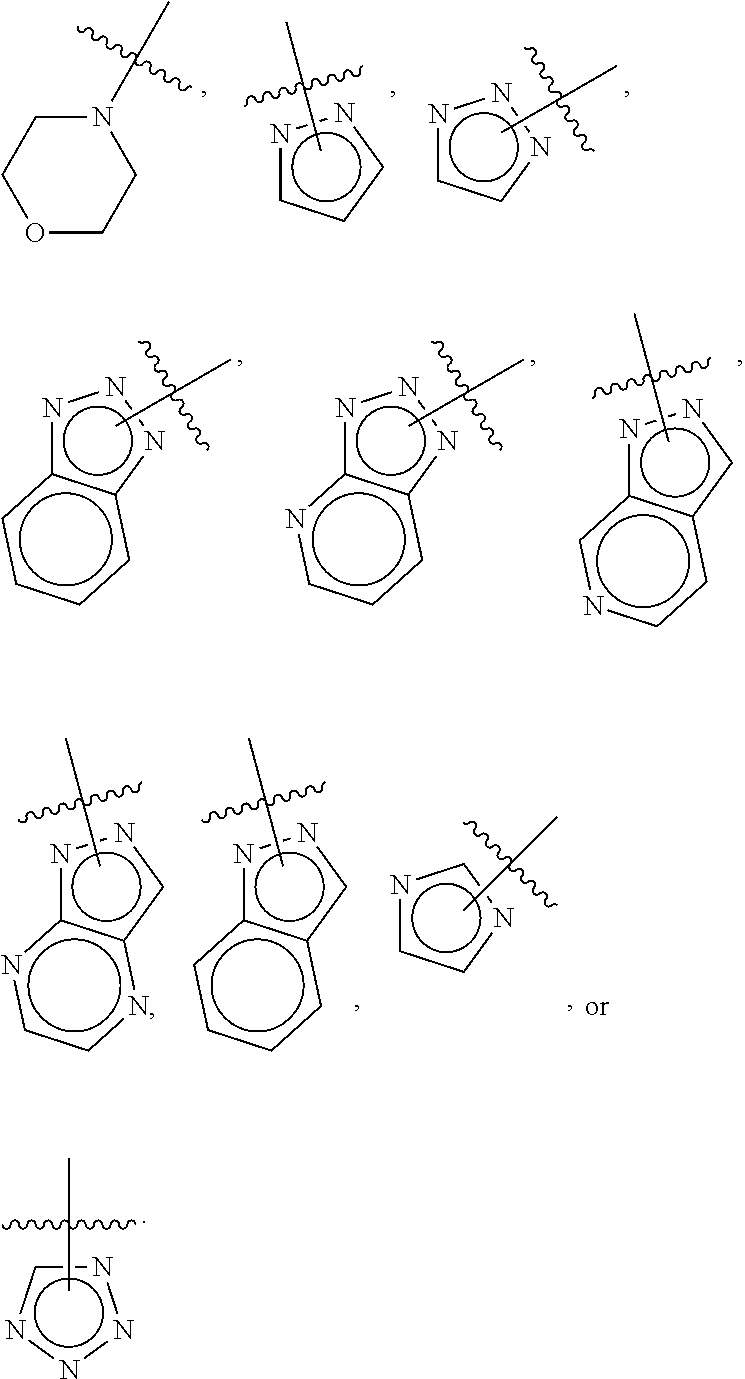Compositions and methods for treating CNS disorders
a technology of cns and compositions, applied in the field of compositions and methods for treating cns disorders, can solve the problems that progesterone is not consistently effective in the treatment of the aforementioned syndromes
- Summary
- Abstract
- Description
- Claims
- Application Information
AI Technical Summary
Benefits of technology
Problems solved by technology
Method used
Image
Examples
example 1
of 1
[0303]
[0304]To a suspension of A1 (170 mg, 0.4 mmol) in acetonitrile (3.5 mL) was added potassium carbonate (340 mg, 2.4 mmol) and morpholine (340 mg, 3.9 mmol) at 10° C. The mixture was stirred at 30° C. for 5 hours and then concentrated under vacuum, washed with water, purified by column chromatography on silica gel (eluent: petrol ether:ethyl acetate=2:1 to 1:2) to give 1 (94.1 mg, 55%) as white solid.
[0305]1H NMR: (400 MHz, CDCl3) δ 4.02-3.90 (m, 1H), 3.75 (t, J=4.4 Hz, 4H), 3.48-3.30 (m, 4H), 3.20-3.18 (m, 2H), 2.61-2.40 (m, 5H), 2.22-2.08 (m, 1H), 1.92-1.78 (m, 3H), 1.73-1.48 (m, 6H), 1.40-1.15 (m, 9H), 0.99-0.88 (m, 4H), 0.80-0.68 (m, 1H), 0.61 (s, 3H).
example 2
of 2 and 3
[0306]
[0307]To a suspension of A1 (260 mg, 0.61 mmol) in acetonitrile (5 mL) was added potassium carbonate (500 mg, 3.6 mmol) and 1,2,3-triazole (500 mg, 7.2 mmol) at 10° C. The mixture was stirred at 30° C. for 5 hours and then concentrated under vacuum. To the residue was added washed, extracted with ethyl acetate. The organic layer was dried over anhydrous sodium sulfate, purified by prep-HPLC to give 2 (38.1 mg, 15%) and 3 (71.5 mg, 28%) as white solid. 1H NMR (2): (400 MHz, CDCl3) δ 7.68 (s, 2H), 5.32-5.15 (m, 2H), 4.01-3.91 (m, 1H), 3.41-3.29 (m, 4H), 2.62-2.50 (m, 1H), 2.28-2.14 (m, 1H), 2.13-2.04 (m, 1H), 1.95-1.88 (m, 1H), 1.88-1.62 (m, 5H), 1.56-1.19 (m, 11H), 1.02-0.95 (m, 1H), 0.93 (s, 3H), 0.81-0.72 (m, 1H), 0.69 (s, 3H).
[0308]1H NMR (3): (400 MHz, CDCl3) δ 7.75 (s, 1H), 7.64 (s, 1H), 5.32-5.09 (m, 2H), 4.01-3.91 (m, 1H), 3.41-3.29 (m, 4H), 2.70-2.58 (m, 1H), 2.28-2.14 (m, 1H), 2.12-2.04 (m, 1H), 1.95-1.88 (m, 1H), 1.88-1.62 (m, 5H), 1.56-1.20 (m, 11H), 1.03-0...
example 3
of 4 and 5
[0309]
Step 1. Synthesis of A3
[0310]To a solution of Ph3PCH2CH2Br (60.41 g, 163.16 mmol) in THF (40 mL) was added a solution of t-BuOK (18.31 g, 163.16 mmol) in THF (20 mL) under N2 atmosphere. The mixture was stirred at 15° C. for 1 h. Then the solution of A2 (10 g, 32.63 mmol) in THF (40 mL) was added and the mixture was stirred under reflux for 3 h. TLC (ethyl acetate / petroleum ether=l / l) showed that the starting material was consumed completely. The mixture was cooled and quenched with saturate NH4Cl aqueous (40 mL). The mixture was extracted with EtOAc (60 mL*3). The combined organic layers was washed with brine (50 mL), dried over anhydrous Na2SO4 and evaporated in vacuo to give crude, which was purified by column chromatography on silica gel (ethyl acetate / petroleum ether=1 / 10) to afford A3 (6.8 g, 65%) as a white solid.
[0311]1H NMR (A3): (400 MHz, CDCl3) δ 5.11-5.02 (m, 1H), 4.39-4.35 (m, 1H), 4.07-4.02 (m, 1H), 2.41-2.32 (m, 2H), 2.21-2.09 (m, 2H), 1.91-1.71 (m, 4H...
PUM
 Login to View More
Login to View More Abstract
Description
Claims
Application Information
 Login to View More
Login to View More - R&D
- Intellectual Property
- Life Sciences
- Materials
- Tech Scout
- Unparalleled Data Quality
- Higher Quality Content
- 60% Fewer Hallucinations
Browse by: Latest US Patents, China's latest patents, Technical Efficacy Thesaurus, Application Domain, Technology Topic, Popular Technical Reports.
© 2025 PatSnap. All rights reserved.Legal|Privacy policy|Modern Slavery Act Transparency Statement|Sitemap|About US| Contact US: help@patsnap.com



